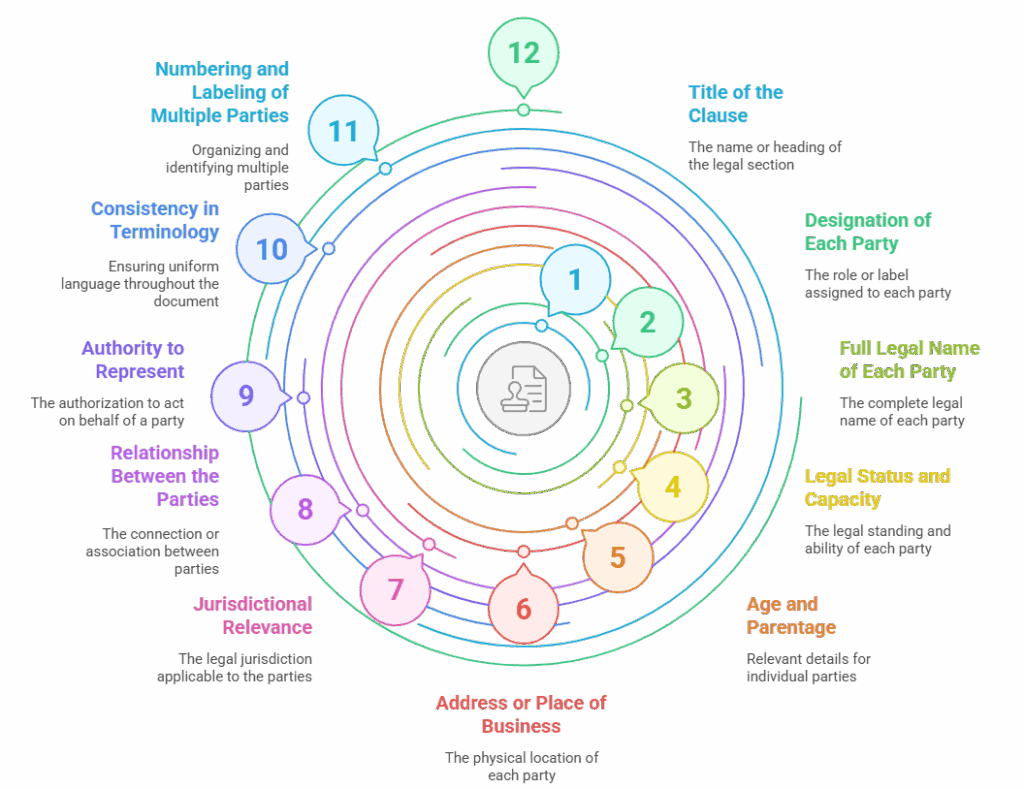Drafting a flawless “Introduction to Parties” clause is essential for establishing the identities and roles of the parties involved in a contract. Here’s a comprehensive guide on how to draft this clause effectively.
Definition of Introduction to Parties Clause
The “Introduction to Parties” clause identifies the parties entering into the contract, providing their legal names, addresses, and any relevant designations. This clause sets the stage for the entire agreement and ensures clarity regarding who is involved.
It includes their names, status (plaintiff, defendant, petitioner, respondent), legal capacity (individual, company, minor, etc.), and relevant background to establish standing and context.

Step-by-Step Drafting of the Clause
- Identify the Parties : Determine the legal names of all parties involved. This includes individuals, companies, or organizations.
- Include Addresses : Provide the registered addresses of each party. This is crucial for legal correspondence.
- Designate Roles : Clearly state the role of each party (e.g., “Buyer,” “Seller,” “Lender,” “Borrower”).
- Use Consistent Terminology : After the initial introduction, use consistent terms to refer to each party throughout the contract (e.g., “Party A,” “Party B”).
- Include Additional Information : If applicable, mention any relevant details such as the capacity in which a party is acting (e.g., a trustee, guardian, or representative).
Examples of Introduction to Parties Clause
Civil Suit (Property Dispute)
The Plaintiff, Mr. Ramesh Mehta, son of Late Shri D.K. Mehta, aged about 48 years, residing at 102, East Avenue, Jaipur, Rajasthan, is the rightful owner of the suit property and is filing the present suit for recovery of possession.
The Defendant, Mr. Mohan Mehta, son of Shri D.K. Mehta, aged about 51 years, residing at 105, East Avenue, Jaipur, Rajasthan, is the elder brother of the Plaintiff and is unlawfully occupying the said property.
Commercial Suit (Breach of Contract)
The Plaintiff, M/s Orion Industries Pvt. Ltd., a company incorporated under the Companies Act, 2013, having its registered office at 101, Nehru Place, New Delhi, is engaged in the manufacture of precision machinery.
The Defendant, M/s Apex Solutions, a registered partnership firm having its principal place of business at 45, Industrial Area, Pune, Maharashtra, entered into a contract dated 12.06.2023 with the Plaintiff, which forms the basis of the present dispute.
Family Law (Divorce Petition)
The Petitioner, Mrs. Anjali Verma, daughter of Mr. Mahendra Lal, aged 30 years, currently residing at 22, South Extension, New Delhi, was lawfully married to the Respondent on 15.03.2017.
The Respondent, Mr. Rajeev Verma, son of Mr. Raghunath Verma, aged 34 years, residing at 19, Green Park, New Delhi, is the husband of the Petitioner.
Guardianship Petition (Minor Child)
The Petitioner, Mrs. Sunita Rao, widow of Late Mr. Ajay Rao, residing at 88, MG Road, Bangalore, is the natural mother and legal guardian of Master Aarav Rao, aged 10 years.
The Respondent, Mr. Vinod Rao, brother of the deceased father, residing at 77, JP Nagar, Bangalore, is opposing the guardianship of the said minor.
Writ Petition (Against Public Authority)
The Petitioner, Mr. Akash Jain, son of Mr. N.K. Jain, aged 36 years, resident of 201, Saket, New Delhi, is a citizen of India and has approached this Hon’ble Court under Article 226 of the Constitution of India.
The Respondent No.1 is the Union of India, through its Secretary, Ministry of Environment, Forest and Climate Change, having its office at Indira Paryavaran Bhavan, New Delhi.
The Respondent No.2 is the Central Pollution Control Board, through its Chairman, located at Parivesh Bhawan, East Arjun Nagar, Delhi.
Practical Advice on Drafting the Clause
- Double-Check Legal Names : Ensure that the legal names of the parties are accurate and up-to-date.
- Consider Future Changes : If a party may change (e.g., a company may undergo a name change), consider including a clause that addresses this.
- Use Clear Language : Avoid jargon or overly complex language to ensure that the clause is easily understood.
- Consult Legal Resources : If unsure, refer to legal drafting resources or consult with a legal professional to ensure compliance with applicable laws.
By following these guidelines, you can draft a clear and effective “Introduction to Parties” clause that serves as a solid foundation for your contract.




